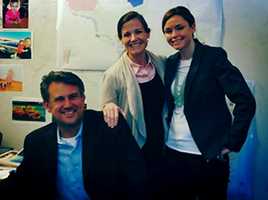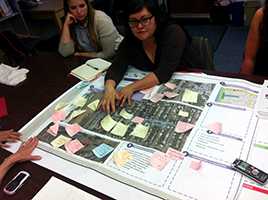On the Road in San Francisco, California
By: Victoria Harp
When my colleague and faithful travel companion, Cori Wigington, and I traveled to San Francisco at the end of April 2013, we were not feeling our best. Because so much time and planning had been invested in this trip, there was no choice but to put on our game faces and power through our head-cold haze. We practiced every CDC-endorsed method to reduce the exposure and the spreading of germs and appreciate everyone being so sympathetic and enduring our meetings. I want to thank each and every person we met!
Learning about San Francisco’s Neighborhood Empowerment Network

4/29/2013 – Daniel Homsey seated at his desk with the visitors from the CDC: Victoria Harp and Cori Wigington.
We were in San Francisco to visit with Daniel Homsey who works for the City Administrator and manages the Neighborhood Empowerment Network (NEN). We wanted to learn about how the NEN, in partnership with many other city agencies, universities, and nonprofits, is helping neighborhoods exemplify FEMA’s Whole Community approach.
Homsey’s position is unique and exists because current and past mayoral administrations have prioritized preparedness and neighborhood empowerment. The leaders of San Francisco are all too familiar with disasters and know that the government cannot be everywhere at once when a disaster strikes. The NEN’s mission is to ensure that people are empowered to take care of themselves and their neighbors. NEN convenes city resources and partners to support neighborhood groups as they craft and implement resilience action plans. The neighborhoods enter into a social contract to participate in the NEN’s Empowered Communities Program, in which they commit to take a leadership role in plan creation and remain engaged throughout the implementation process. The Empowered Communities Program is a tailored framework and flexible support system; however, working with the NEN is a privilege for the community, not a service. What makes this program in San Francisco so unique is that citizen’s work together within their neighborhoods to formulate plans that will engage the government – not the other way around.
Our time in San Francisco was our chance to meet the people that are doing this work: the community leaders that are “walking the walk.” There are numerous articles on what should be done to build community resilience, but there is little discussion on how to do it. The CDC intends to submit scholarly articles for publication on the findings from the Whole Community visits that will articulate the “how,” but for now, here is a great example.
How to Achieve Community Resilience

4/30/2013 - Jen Gasang brought a visual aide that helped her describe the work that led to the N Judah Turnaround Project.
On our second day in San Francisco, we met with community leader Jen Gasang. Gasang was seated among a group representing a university, NERT (San Francisco’s CERT), and community volunteers, but Jen stood out. She was hard to miss with her posters laden with post-it notes, infographics, and a passion for her community that came pouring out at a rapid, fast-talking pace. Gasang is a community organizer and natural collaborator living in the Outer Sunset neighborhood located in the western part of San Francisco. Gasang has a knack for finding people interested in her neighborhood, connects with them, and brings them together.
One day, while walking her three-legged dog in her neighborhood community garden, La Playa Park, Gasang began chatting with Steve Ward. They soon discovered that they had very similar interests. Ward had a small network of people that had been working on city partnerships in support of La Playa Park. As he was getting older, he had started to look to the younger generation to take over leadership for the neighborhood’s sustainability. This was when Ward began to stop Gasang on her walks. Gasang had valuable connections in her professional life from her community activism work at San Francisco State University and at City Hall. She knew Homsey and reached out to him about the NEN. Ward and Gasang gathered their mutual, interested connections and spread the news through word of mouth that there would be a community meeting in August 2012.
This meeting was structured with the help of the NEN. At the meeting, they gathered input and prioritized their first neighborhood project: the N-Judah Turnaround Beautification Project. Gasang describes the N-Judah Beautification Project as an “entry point” that garnered total community buy-in; they were so proud that it was developed solely on neighborhood feedback and the assurance that the citizens would be invested in the process.
Beautification to Community Resilience: N-Judah Turnaround Project
The N-Judah turnaround is a section of the Bay Area’s metro transit that goes all the way to the western part of San Francisco and meets at the Outer Sunset neighborhood park. This heavily traveled area was an eyesore and safety hazard for the entire community. For these reasons, the entire community invested in making it better. While working on this project, the neighborhood developed a coalition to include local businesses, public safety, faith-based, and city partners. Creating this social capital structure has allowed the Outer Sunset neighborhood to address other issues identified through neighborhood feedback. Even though at the moment everyone is invested in the beautification of the turnaround, people are already looking towards the next project. The citizens of Outer Sunset all want more for this community. Homsey says the NEN will continue providing the Outer Sunset neighborhood with its partner resources, because every step taken to address a neighborhood issue makes a more resilient neighborhood. Resilient neighborhoods will lead to a resilient city.
The Outer Sunset neighborhood has been historically overlooked because of its geographic distance from the center of the City and typically stays off of City Hall’s radar. However, residents have come together as a group to give a voice to this normally quiet place. As a result, this community has advocacy and power in numbers. Gasang says the N-Judah Turnaround Project was the crucial step they needed to achieve community buy-in. With the network of the NEN, they have city partners ready to support them when they tackle disaster preparedness.
How a neighborhood starts to build resiliency could be as simple as stopping to talk to a neighbor while walking your dog. The community of San Francisco is very unique in supporting a leadership approach that begins in a neighborhood. So often, it is not first responders pulling people out of rubble. It is the next door neighbor. San Francisco, by empowering these neighbors now and supporting their efforts, will be a more resilient community when disaster strikes again.
To learn more about the Neighborhood Empowerment Network (NEN) and the Empowered Communities Program, please visit: http://empowersf.org/
To learn more about the N Judah Turnaround Project, please visit: empowersf.org/njudahproject/
Victoria Harp has been supporting the CDC’s Office of Public Health Preparedness and Response Learning Office as a Contractor for Lockheed Martin since 2009. She has been a Project Coordinator for the Meta-Leadership Summit for Preparedness Initiative and is currently supporting the Learning Office working with the CDC Foundation and FEMA for the Whole Community Program.
- Page last reviewed: April 10, 2015
- Page last updated: April 10, 2015
- Content source:


 ShareCompartir
ShareCompartir